Financial Performance Management Report: Environmental Costs and Tools
VerifiedAdded on 2023/01/04
|13
|3785
|61
Report
AI Summary
This report delves into the intricacies of financial performance management, focusing on the challenges businesses face in managing environmental costs and the various methods employed to address them. It examines environmental management accounting, differentiating between physical and monetary information, and highlights its role in reallocating environmental costs to specific products. The report discusses the issues related to environmental costs, including prevention, appraisal, internal and external failure costs, and the application of cost-benefit analysis. It explores techniques such as life cycle assessment, flow cost accounting, activity-based costing, and input/output analysis. Furthermore, the report investigates management accounting tools for solving financial problems, including relevant cost analysis, audience targeting, and operational efficiency. The importance of financial planning tools, such as wealth-growing and protection tools, is also considered, along with strategies like cash flow management to overcome financial challenges.
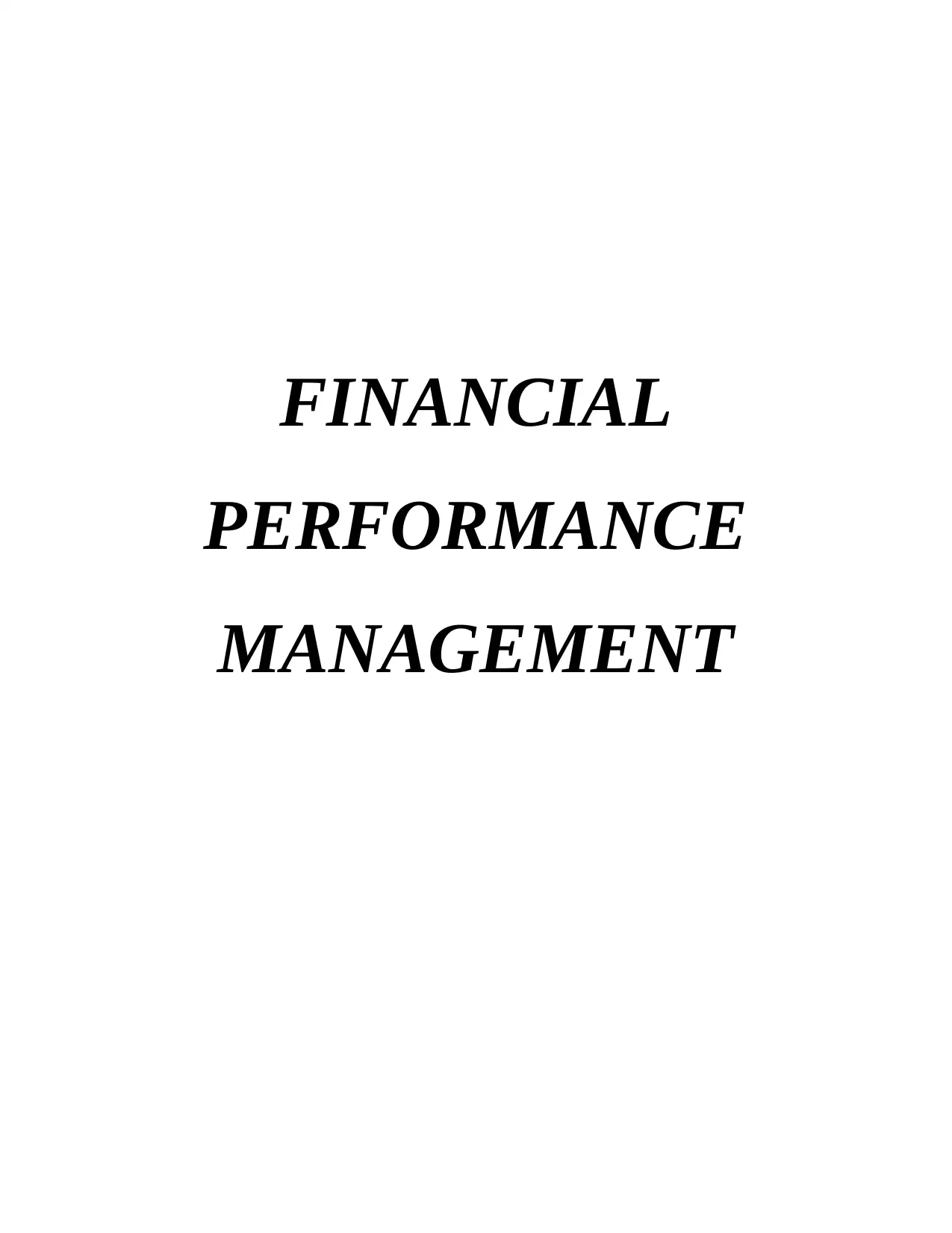
FINANCIAL
PERFORMANCE
MANAGEMENT
PERFORMANCE
MANAGEMENT
Paraphrase This Document
Need a fresh take? Get an instant paraphrase of this document with our AI Paraphraser
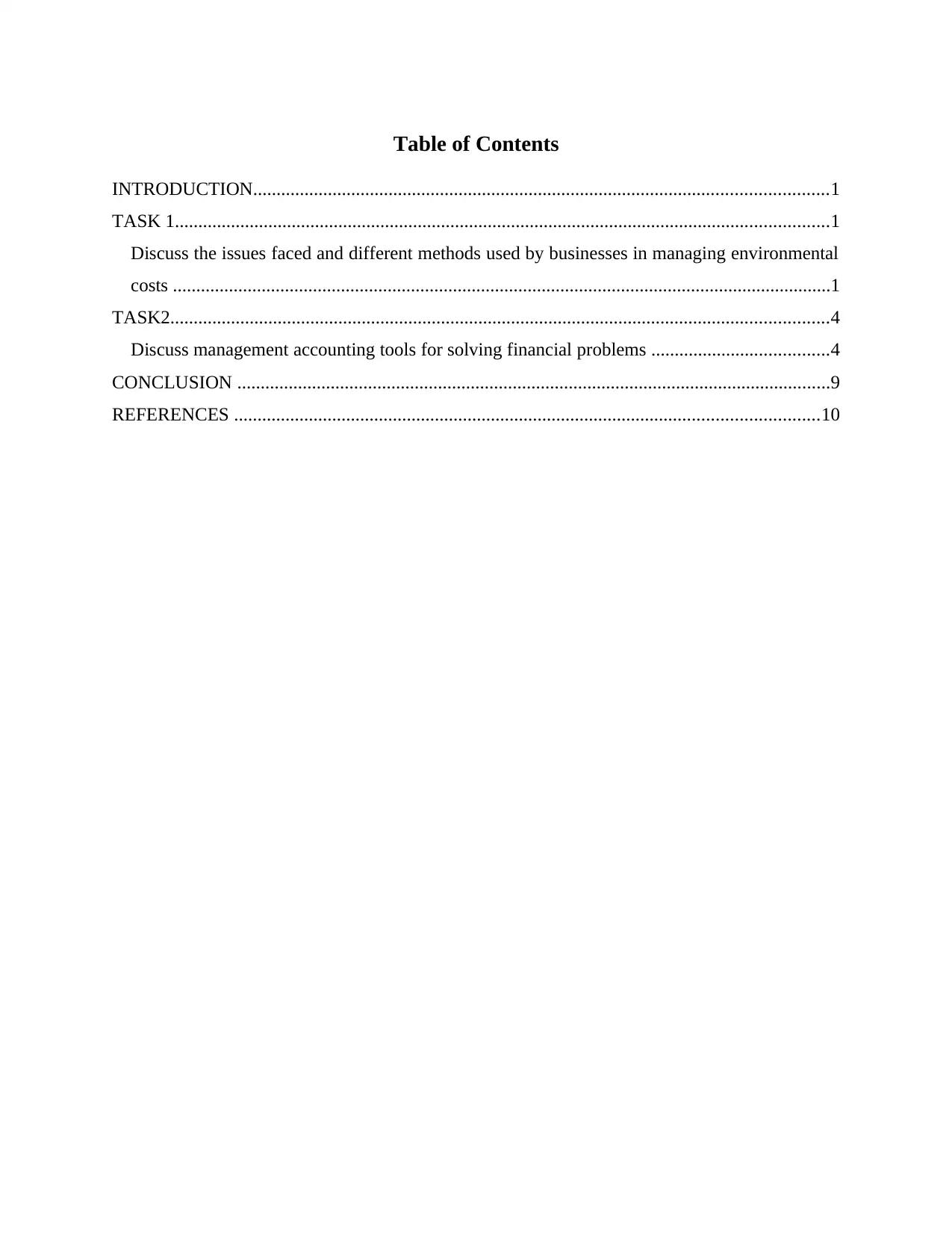
Table of Contents
INTRODUCTION...........................................................................................................................1
TASK 1............................................................................................................................................1
Discuss the issues faced and different methods used by businesses in managing environmental
costs .............................................................................................................................................1
TASK2.............................................................................................................................................4
Discuss management accounting tools for solving financial problems ......................................4
CONCLUSION ...............................................................................................................................9
REFERENCES .............................................................................................................................10
INTRODUCTION...........................................................................................................................1
TASK 1............................................................................................................................................1
Discuss the issues faced and different methods used by businesses in managing environmental
costs .............................................................................................................................................1
TASK2.............................................................................................................................................4
Discuss management accounting tools for solving financial problems ......................................4
CONCLUSION ...............................................................................................................................9
REFERENCES .............................................................................................................................10
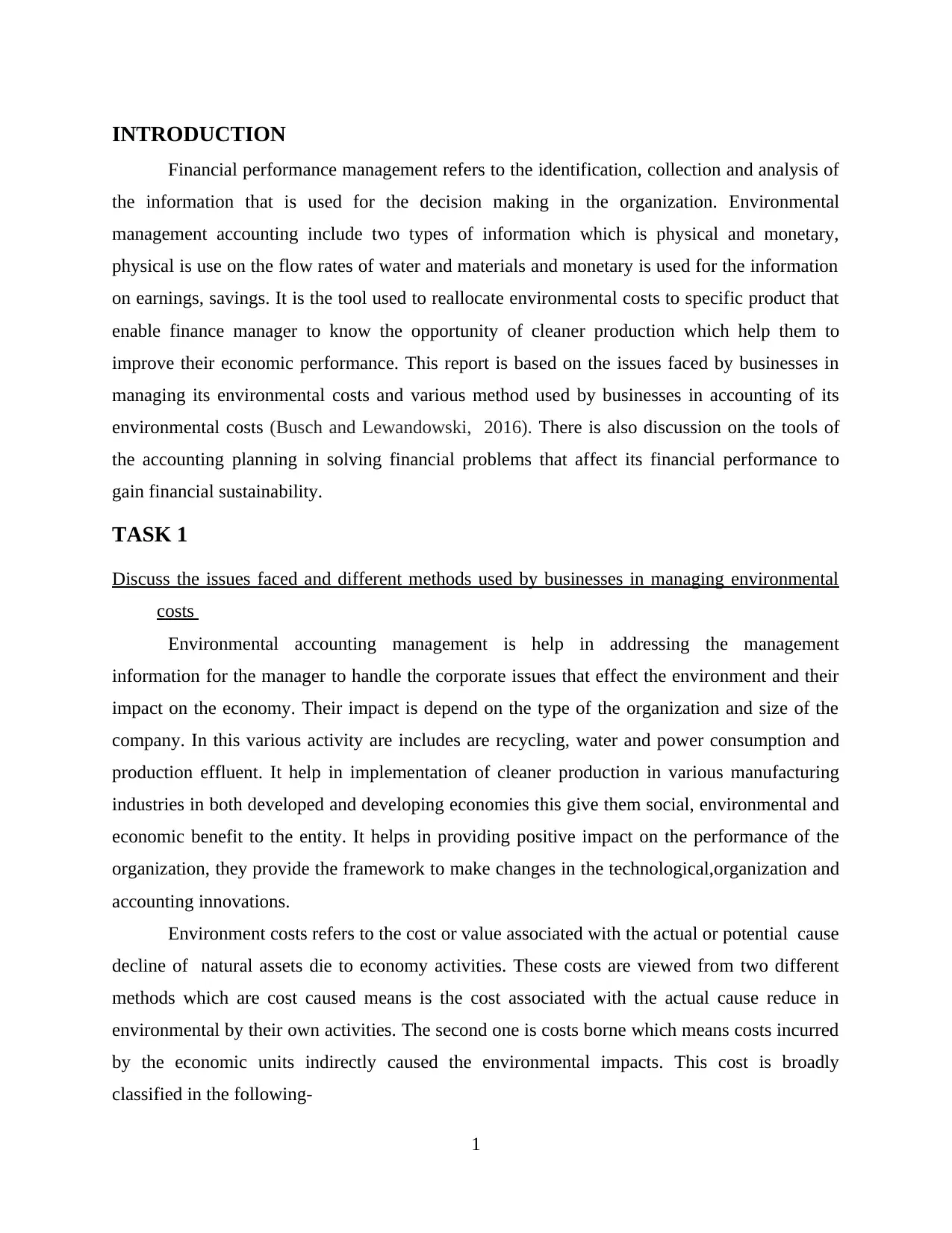
INTRODUCTION
Financial performance management refers to the identification, collection and analysis of
the information that is used for the decision making in the organization. Environmental
management accounting include two types of information which is physical and monetary,
physical is use on the flow rates of water and materials and monetary is used for the information
on earnings, savings. It is the tool used to reallocate environmental costs to specific product that
enable finance manager to know the opportunity of cleaner production which help them to
improve their economic performance. This report is based on the issues faced by businesses in
managing its environmental costs and various method used by businesses in accounting of its
environmental costs (Busch and Lewandowski, 2016). There is also discussion on the tools of
the accounting planning in solving financial problems that affect its financial performance to
gain financial sustainability.
TASK 1
Discuss the issues faced and different methods used by businesses in managing environmental
costs
Environmental accounting management is help in addressing the management
information for the manager to handle the corporate issues that effect the environment and their
impact on the economy. Their impact is depend on the type of the organization and size of the
company. In this various activity are includes are recycling, water and power consumption and
production effluent. It help in implementation of cleaner production in various manufacturing
industries in both developed and developing economies this give them social, environmental and
economic benefit to the entity. It helps in providing positive impact on the performance of the
organization, they provide the framework to make changes in the technological,organization and
accounting innovations.
Environment costs refers to the cost or value associated with the actual or potential cause
decline of natural assets die to economy activities. These costs are viewed from two different
methods which are cost caused means is the cost associated with the actual cause reduce in
environmental by their own activities. The second one is costs borne which means costs incurred
by the economic units indirectly caused the environmental impacts. This cost is broadly
classified in the following-
1
Financial performance management refers to the identification, collection and analysis of
the information that is used for the decision making in the organization. Environmental
management accounting include two types of information which is physical and monetary,
physical is use on the flow rates of water and materials and monetary is used for the information
on earnings, savings. It is the tool used to reallocate environmental costs to specific product that
enable finance manager to know the opportunity of cleaner production which help them to
improve their economic performance. This report is based on the issues faced by businesses in
managing its environmental costs and various method used by businesses in accounting of its
environmental costs (Busch and Lewandowski, 2016). There is also discussion on the tools of
the accounting planning in solving financial problems that affect its financial performance to
gain financial sustainability.
TASK 1
Discuss the issues faced and different methods used by businesses in managing environmental
costs
Environmental accounting management is help in addressing the management
information for the manager to handle the corporate issues that effect the environment and their
impact on the economy. Their impact is depend on the type of the organization and size of the
company. In this various activity are includes are recycling, water and power consumption and
production effluent. It help in implementation of cleaner production in various manufacturing
industries in both developed and developing economies this give them social, environmental and
economic benefit to the entity. It helps in providing positive impact on the performance of the
organization, they provide the framework to make changes in the technological,organization and
accounting innovations.
Environment costs refers to the cost or value associated with the actual or potential cause
decline of natural assets die to economy activities. These costs are viewed from two different
methods which are cost caused means is the cost associated with the actual cause reduce in
environmental by their own activities. The second one is costs borne which means costs incurred
by the economic units indirectly caused the environmental impacts. This cost is broadly
classified in the following-
1
⊘ This is a preview!⊘
Do you want full access?
Subscribe today to unlock all pages.

Trusted by 1+ million students worldwide
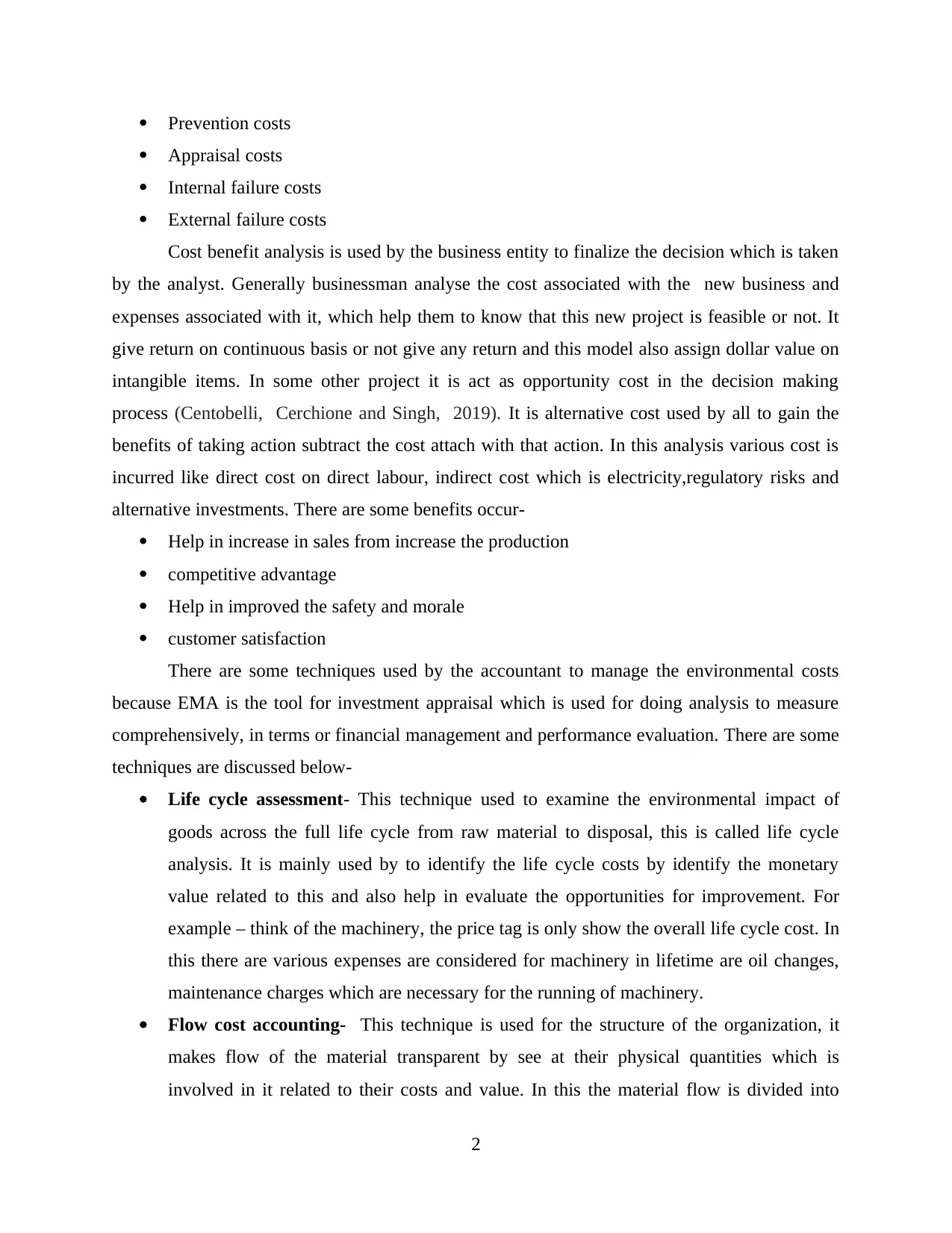
Prevention costs
Appraisal costs
Internal failure costs
External failure costs
Cost benefit analysis is used by the business entity to finalize the decision which is taken
by the analyst. Generally businessman analyse the cost associated with the new business and
expenses associated with it, which help them to know that this new project is feasible or not. It
give return on continuous basis or not give any return and this model also assign dollar value on
intangible items. In some other project it is act as opportunity cost in the decision making
process (Centobelli, Cerchione and Singh, 2019). It is alternative cost used by all to gain the
benefits of taking action subtract the cost attach with that action. In this analysis various cost is
incurred like direct cost on direct labour, indirect cost which is electricity,regulatory risks and
alternative investments. There are some benefits occur-
Help in increase in sales from increase the production
competitive advantage
Help in improved the safety and morale
customer satisfaction
There are some techniques used by the accountant to manage the environmental costs
because EMA is the tool for investment appraisal which is used for doing analysis to measure
comprehensively, in terms or financial management and performance evaluation. There are some
techniques are discussed below-
Life cycle assessment- This technique used to examine the environmental impact of
goods across the full life cycle from raw material to disposal, this is called life cycle
analysis. It is mainly used by to identify the life cycle costs by identify the monetary
value related to this and also help in evaluate the opportunities for improvement. For
example – think of the machinery, the price tag is only show the overall life cycle cost. In
this there are various expenses are considered for machinery in lifetime are oil changes,
maintenance charges which are necessary for the running of machinery.
Flow cost accounting- This technique is used for the structure of the organization, it
makes flow of the material transparent by see at their physical quantities which is
involved in it related to their costs and value. In this the material flow is divided into
2
Appraisal costs
Internal failure costs
External failure costs
Cost benefit analysis is used by the business entity to finalize the decision which is taken
by the analyst. Generally businessman analyse the cost associated with the new business and
expenses associated with it, which help them to know that this new project is feasible or not. It
give return on continuous basis or not give any return and this model also assign dollar value on
intangible items. In some other project it is act as opportunity cost in the decision making
process (Centobelli, Cerchione and Singh, 2019). It is alternative cost used by all to gain the
benefits of taking action subtract the cost attach with that action. In this analysis various cost is
incurred like direct cost on direct labour, indirect cost which is electricity,regulatory risks and
alternative investments. There are some benefits occur-
Help in increase in sales from increase the production
competitive advantage
Help in improved the safety and morale
customer satisfaction
There are some techniques used by the accountant to manage the environmental costs
because EMA is the tool for investment appraisal which is used for doing analysis to measure
comprehensively, in terms or financial management and performance evaluation. There are some
techniques are discussed below-
Life cycle assessment- This technique used to examine the environmental impact of
goods across the full life cycle from raw material to disposal, this is called life cycle
analysis. It is mainly used by to identify the life cycle costs by identify the monetary
value related to this and also help in evaluate the opportunities for improvement. For
example – think of the machinery, the price tag is only show the overall life cycle cost. In
this there are various expenses are considered for machinery in lifetime are oil changes,
maintenance charges which are necessary for the running of machinery.
Flow cost accounting- This technique is used for the structure of the organization, it
makes flow of the material transparent by see at their physical quantities which is
involved in it related to their costs and value. In this the material flow is divided into
2
Paraphrase This Document
Need a fresh take? Get an instant paraphrase of this document with our AI Paraphraser
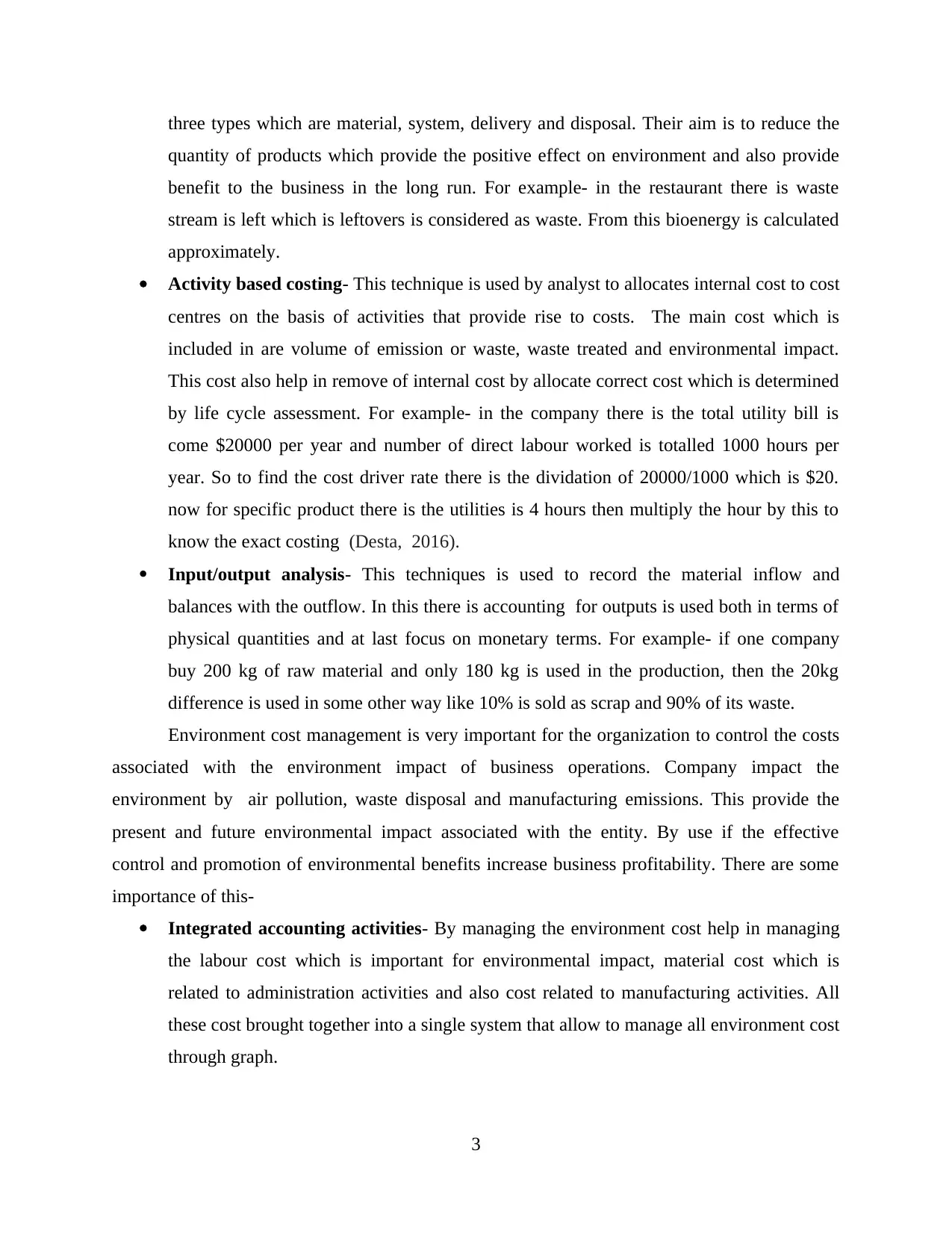
three types which are material, system, delivery and disposal. Their aim is to reduce the
quantity of products which provide the positive effect on environment and also provide
benefit to the business in the long run. For example- in the restaurant there is waste
stream is left which is leftovers is considered as waste. From this bioenergy is calculated
approximately.
Activity based costing- This technique is used by analyst to allocates internal cost to cost
centres on the basis of activities that provide rise to costs. The main cost which is
included in are volume of emission or waste, waste treated and environmental impact.
This cost also help in remove of internal cost by allocate correct cost which is determined
by life cycle assessment. For example- in the company there is the total utility bill is
come $20000 per year and number of direct labour worked is totalled 1000 hours per
year. So to find the cost driver rate there is the dividation of 20000/1000 which is $20.
now for specific product there is the utilities is 4 hours then multiply the hour by this to
know the exact costing (Desta, 2016).
Input/output analysis- This techniques is used to record the material inflow and
balances with the outflow. In this there is accounting for outputs is used both in terms of
physical quantities and at last focus on monetary terms. For example- if one company
buy 200 kg of raw material and only 180 kg is used in the production, then the 20kg
difference is used in some other way like 10% is sold as scrap and 90% of its waste.
Environment cost management is very important for the organization to control the costs
associated with the environment impact of business operations. Company impact the
environment by air pollution, waste disposal and manufacturing emissions. This provide the
present and future environmental impact associated with the entity. By use if the effective
control and promotion of environmental benefits increase business profitability. There are some
importance of this-
Integrated accounting activities- By managing the environment cost help in managing
the labour cost which is important for environmental impact, material cost which is
related to administration activities and also cost related to manufacturing activities. All
these cost brought together into a single system that allow to manage all environment cost
through graph.
3
quantity of products which provide the positive effect on environment and also provide
benefit to the business in the long run. For example- in the restaurant there is waste
stream is left which is leftovers is considered as waste. From this bioenergy is calculated
approximately.
Activity based costing- This technique is used by analyst to allocates internal cost to cost
centres on the basis of activities that provide rise to costs. The main cost which is
included in are volume of emission or waste, waste treated and environmental impact.
This cost also help in remove of internal cost by allocate correct cost which is determined
by life cycle assessment. For example- in the company there is the total utility bill is
come $20000 per year and number of direct labour worked is totalled 1000 hours per
year. So to find the cost driver rate there is the dividation of 20000/1000 which is $20.
now for specific product there is the utilities is 4 hours then multiply the hour by this to
know the exact costing (Desta, 2016).
Input/output analysis- This techniques is used to record the material inflow and
balances with the outflow. In this there is accounting for outputs is used both in terms of
physical quantities and at last focus on monetary terms. For example- if one company
buy 200 kg of raw material and only 180 kg is used in the production, then the 20kg
difference is used in some other way like 10% is sold as scrap and 90% of its waste.
Environment cost management is very important for the organization to control the costs
associated with the environment impact of business operations. Company impact the
environment by air pollution, waste disposal and manufacturing emissions. This provide the
present and future environmental impact associated with the entity. By use if the effective
control and promotion of environmental benefits increase business profitability. There are some
importance of this-
Integrated accounting activities- By managing the environment cost help in managing
the labour cost which is important for environmental impact, material cost which is
related to administration activities and also cost related to manufacturing activities. All
these cost brought together into a single system that allow to manage all environment cost
through graph.
3
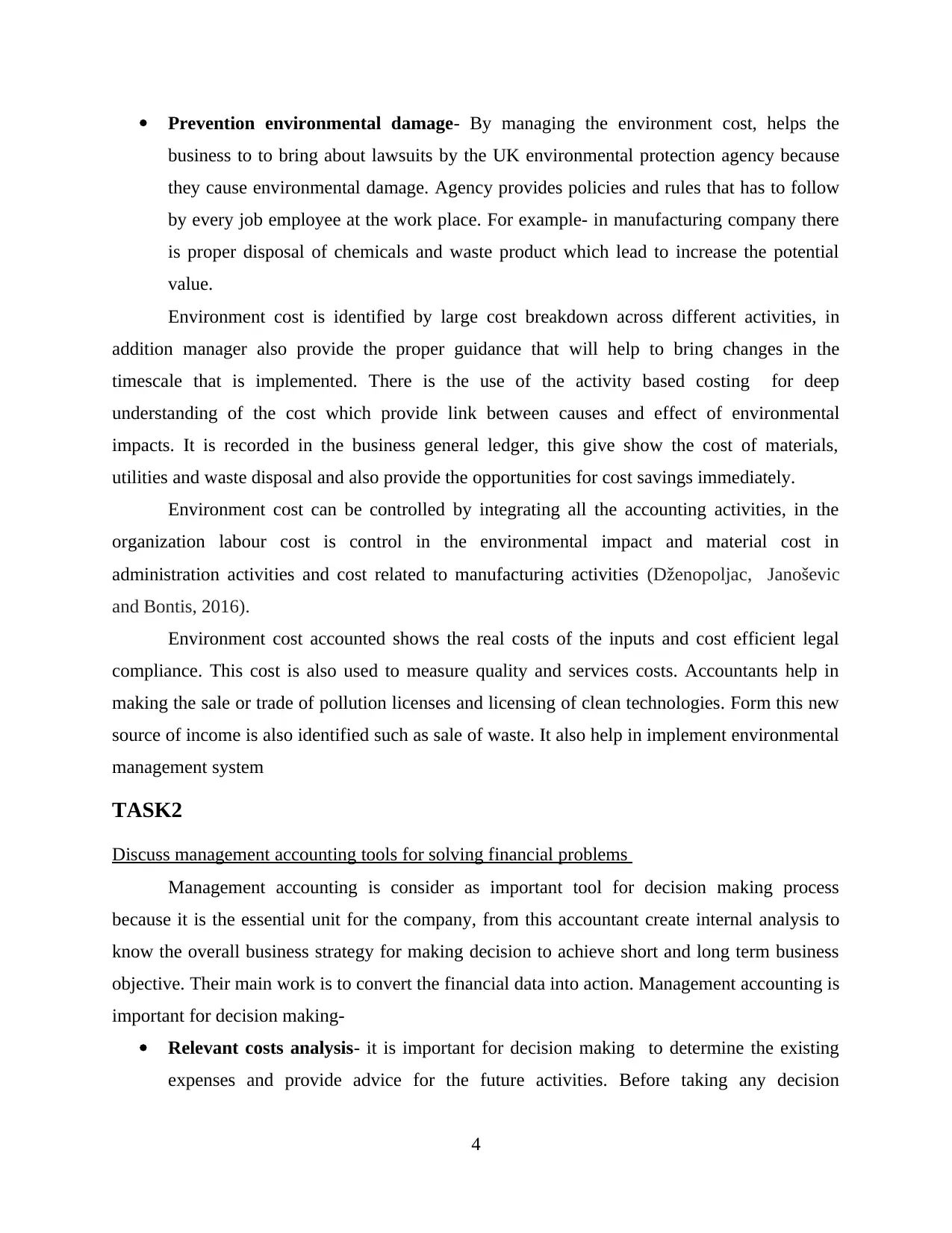
Prevention environmental damage- By managing the environment cost, helps the
business to to bring about lawsuits by the UK environmental protection agency because
they cause environmental damage. Agency provides policies and rules that has to follow
by every job employee at the work place. For example- in manufacturing company there
is proper disposal of chemicals and waste product which lead to increase the potential
value.
Environment cost is identified by large cost breakdown across different activities, in
addition manager also provide the proper guidance that will help to bring changes in the
timescale that is implemented. There is the use of the activity based costing for deep
understanding of the cost which provide link between causes and effect of environmental
impacts. It is recorded in the business general ledger, this give show the cost of materials,
utilities and waste disposal and also provide the opportunities for cost savings immediately.
Environment cost can be controlled by integrating all the accounting activities, in the
organization labour cost is control in the environmental impact and material cost in
administration activities and cost related to manufacturing activities (Dženopoljac, Janoševic
and Bontis, 2016).
Environment cost accounted shows the real costs of the inputs and cost efficient legal
compliance. This cost is also used to measure quality and services costs. Accountants help in
making the sale or trade of pollution licenses and licensing of clean technologies. Form this new
source of income is also identified such as sale of waste. It also help in implement environmental
management system
TASK2
Discuss management accounting tools for solving financial problems
Management accounting is consider as important tool for decision making process
because it is the essential unit for the company, from this accountant create internal analysis to
know the overall business strategy for making decision to achieve short and long term business
objective. Their main work is to convert the financial data into action. Management accounting is
important for decision making-
Relevant costs analysis- it is important for decision making to determine the existing
expenses and provide advice for the future activities. Before taking any decision
4
business to to bring about lawsuits by the UK environmental protection agency because
they cause environmental damage. Agency provides policies and rules that has to follow
by every job employee at the work place. For example- in manufacturing company there
is proper disposal of chemicals and waste product which lead to increase the potential
value.
Environment cost is identified by large cost breakdown across different activities, in
addition manager also provide the proper guidance that will help to bring changes in the
timescale that is implemented. There is the use of the activity based costing for deep
understanding of the cost which provide link between causes and effect of environmental
impacts. It is recorded in the business general ledger, this give show the cost of materials,
utilities and waste disposal and also provide the opportunities for cost savings immediately.
Environment cost can be controlled by integrating all the accounting activities, in the
organization labour cost is control in the environmental impact and material cost in
administration activities and cost related to manufacturing activities (Dženopoljac, Janoševic
and Bontis, 2016).
Environment cost accounted shows the real costs of the inputs and cost efficient legal
compliance. This cost is also used to measure quality and services costs. Accountants help in
making the sale or trade of pollution licenses and licensing of clean technologies. Form this new
source of income is also identified such as sale of waste. It also help in implement environmental
management system
TASK2
Discuss management accounting tools for solving financial problems
Management accounting is consider as important tool for decision making process
because it is the essential unit for the company, from this accountant create internal analysis to
know the overall business strategy for making decision to achieve short and long term business
objective. Their main work is to convert the financial data into action. Management accounting is
important for decision making-
Relevant costs analysis- it is important for decision making to determine the existing
expenses and provide advice for the future activities. Before taking any decision
4
⊘ This is a preview!⊘
Do you want full access?
Subscribe today to unlock all pages.

Trusted by 1+ million students worldwide
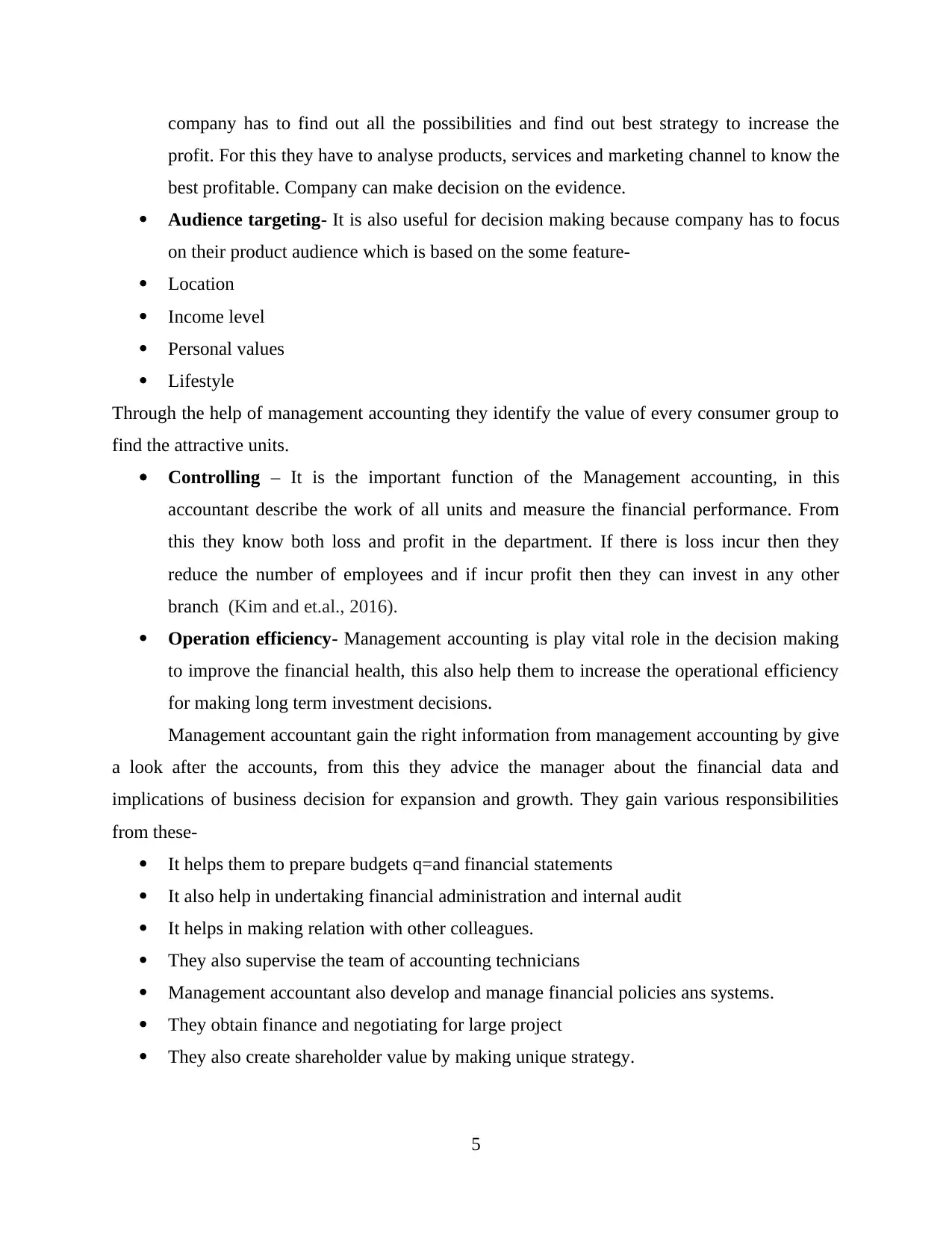
company has to find out all the possibilities and find out best strategy to increase the
profit. For this they have to analyse products, services and marketing channel to know the
best profitable. Company can make decision on the evidence.
Audience targeting- It is also useful for decision making because company has to focus
on their product audience which is based on the some feature-
Location
Income level
Personal values
Lifestyle
Through the help of management accounting they identify the value of every consumer group to
find the attractive units.
Controlling – It is the important function of the Management accounting, in this
accountant describe the work of all units and measure the financial performance. From
this they know both loss and profit in the department. If there is loss incur then they
reduce the number of employees and if incur profit then they can invest in any other
branch (Kim and et.al., 2016).
Operation efficiency- Management accounting is play vital role in the decision making
to improve the financial health, this also help them to increase the operational efficiency
for making long term investment decisions.
Management accountant gain the right information from management accounting by give
a look after the accounts, from this they advice the manager about the financial data and
implications of business decision for expansion and growth. They gain various responsibilities
from these-
It helps them to prepare budgets q=and financial statements
It also help in undertaking financial administration and internal audit
It helps in making relation with other colleagues.
They also supervise the team of accounting technicians
Management accountant also develop and manage financial policies ans systems.
They obtain finance and negotiating for large project
They also create shareholder value by making unique strategy.
5
profit. For this they have to analyse products, services and marketing channel to know the
best profitable. Company can make decision on the evidence.
Audience targeting- It is also useful for decision making because company has to focus
on their product audience which is based on the some feature-
Location
Income level
Personal values
Lifestyle
Through the help of management accounting they identify the value of every consumer group to
find the attractive units.
Controlling – It is the important function of the Management accounting, in this
accountant describe the work of all units and measure the financial performance. From
this they know both loss and profit in the department. If there is loss incur then they
reduce the number of employees and if incur profit then they can invest in any other
branch (Kim and et.al., 2016).
Operation efficiency- Management accounting is play vital role in the decision making
to improve the financial health, this also help them to increase the operational efficiency
for making long term investment decisions.
Management accountant gain the right information from management accounting by give
a look after the accounts, from this they advice the manager about the financial data and
implications of business decision for expansion and growth. They gain various responsibilities
from these-
It helps them to prepare budgets q=and financial statements
It also help in undertaking financial administration and internal audit
It helps in making relation with other colleagues.
They also supervise the team of accounting technicians
Management accountant also develop and manage financial policies ans systems.
They obtain finance and negotiating for large project
They also create shareholder value by making unique strategy.
5
Paraphrase This Document
Need a fresh take? Get an instant paraphrase of this document with our AI Paraphraser
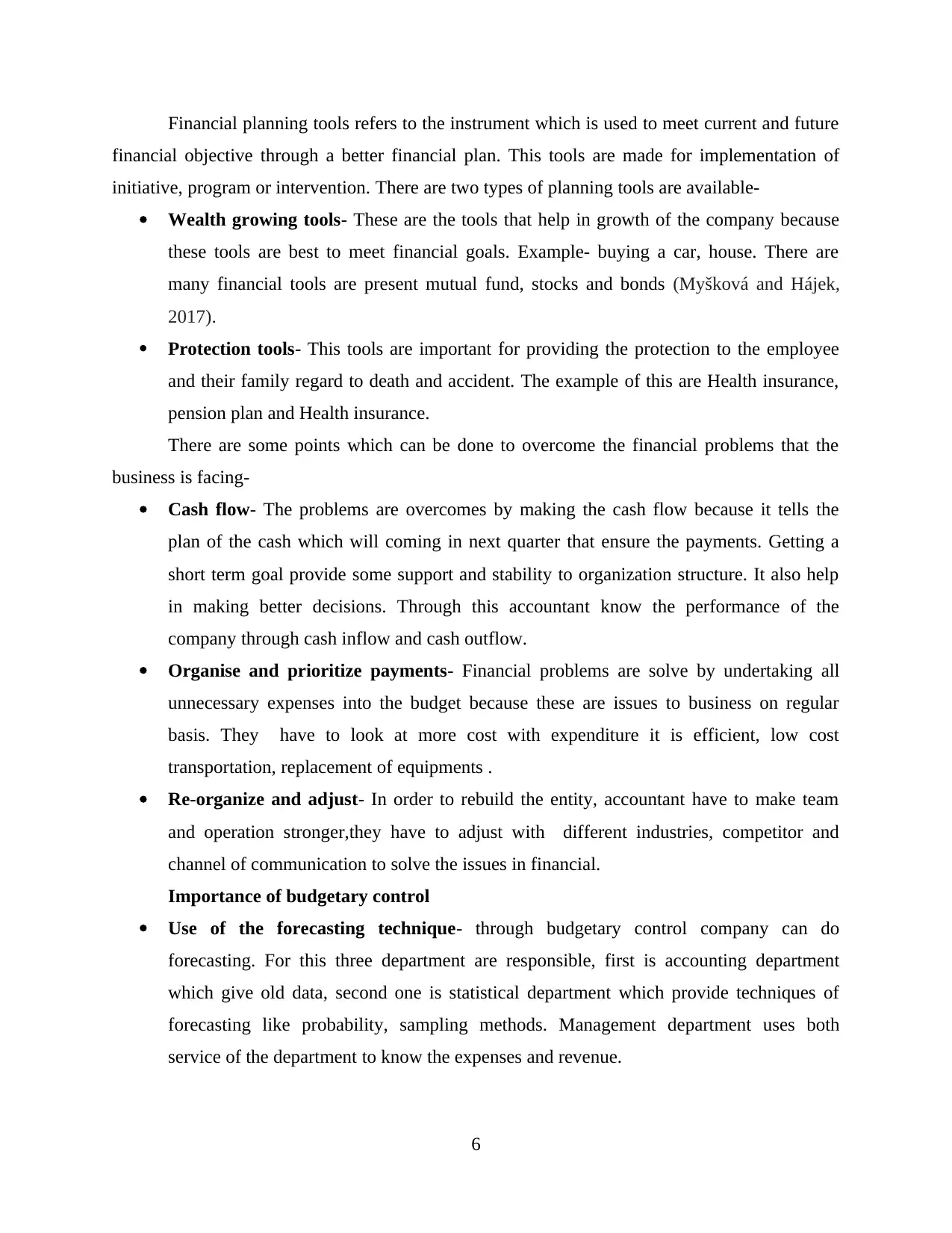
Financial planning tools refers to the instrument which is used to meet current and future
financial objective through a better financial plan. This tools are made for implementation of
initiative, program or intervention. There are two types of planning tools are available-
Wealth growing tools- These are the tools that help in growth of the company because
these tools are best to meet financial goals. Example- buying a car, house. There are
many financial tools are present mutual fund, stocks and bonds (Myšková and Hájek,
2017).
Protection tools- This tools are important for providing the protection to the employee
and their family regard to death and accident. The example of this are Health insurance,
pension plan and Health insurance.
There are some points which can be done to overcome the financial problems that the
business is facing-
Cash flow- The problems are overcomes by making the cash flow because it tells the
plan of the cash which will coming in next quarter that ensure the payments. Getting a
short term goal provide some support and stability to organization structure. It also help
in making better decisions. Through this accountant know the performance of the
company through cash inflow and cash outflow.
Organise and prioritize payments- Financial problems are solve by undertaking all
unnecessary expenses into the budget because these are issues to business on regular
basis. They have to look at more cost with expenditure it is efficient, low cost
transportation, replacement of equipments .
Re-organize and adjust- In order to rebuild the entity, accountant have to make team
and operation stronger,they have to adjust with different industries, competitor and
channel of communication to solve the issues in financial.
Importance of budgetary control
Use of the forecasting technique- through budgetary control company can do
forecasting. For this three department are responsible, first is accounting department
which give old data, second one is statistical department which provide techniques of
forecasting like probability, sampling methods. Management department uses both
service of the department to know the expenses and revenue.
6
financial objective through a better financial plan. This tools are made for implementation of
initiative, program or intervention. There are two types of planning tools are available-
Wealth growing tools- These are the tools that help in growth of the company because
these tools are best to meet financial goals. Example- buying a car, house. There are
many financial tools are present mutual fund, stocks and bonds (Myšková and Hájek,
2017).
Protection tools- This tools are important for providing the protection to the employee
and their family regard to death and accident. The example of this are Health insurance,
pension plan and Health insurance.
There are some points which can be done to overcome the financial problems that the
business is facing-
Cash flow- The problems are overcomes by making the cash flow because it tells the
plan of the cash which will coming in next quarter that ensure the payments. Getting a
short term goal provide some support and stability to organization structure. It also help
in making better decisions. Through this accountant know the performance of the
company through cash inflow and cash outflow.
Organise and prioritize payments- Financial problems are solve by undertaking all
unnecessary expenses into the budget because these are issues to business on regular
basis. They have to look at more cost with expenditure it is efficient, low cost
transportation, replacement of equipments .
Re-organize and adjust- In order to rebuild the entity, accountant have to make team
and operation stronger,they have to adjust with different industries, competitor and
channel of communication to solve the issues in financial.
Importance of budgetary control
Use of the forecasting technique- through budgetary control company can do
forecasting. For this three department are responsible, first is accounting department
which give old data, second one is statistical department which provide techniques of
forecasting like probability, sampling methods. Management department uses both
service of the department to know the expenses and revenue.
6
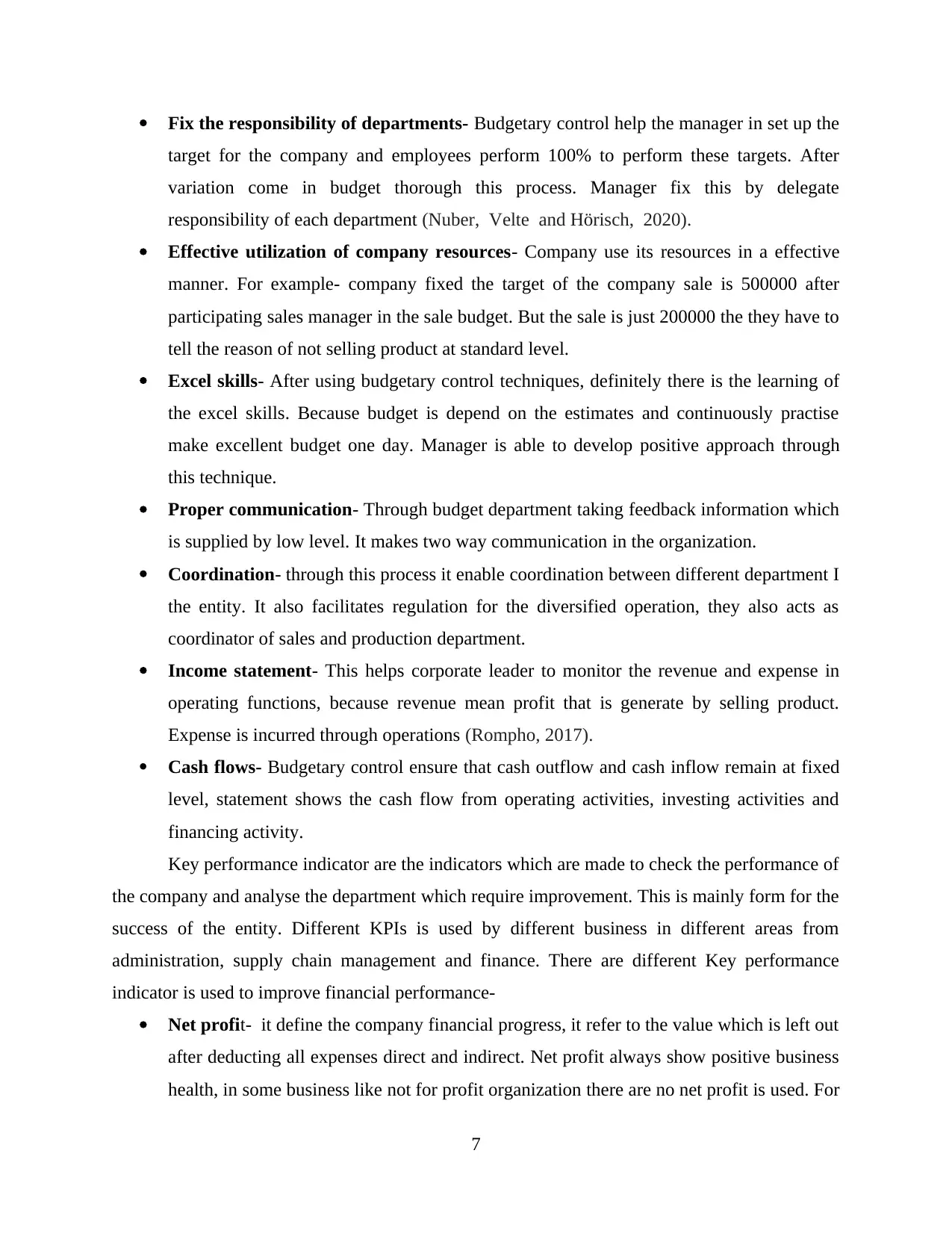
Fix the responsibility of departments- Budgetary control help the manager in set up the
target for the company and employees perform 100% to perform these targets. After
variation come in budget thorough this process. Manager fix this by delegate
responsibility of each department (Nuber, Velte and Hörisch, 2020).
Effective utilization of company resources- Company use its resources in a effective
manner. For example- company fixed the target of the company sale is 500000 after
participating sales manager in the sale budget. But the sale is just 200000 the they have to
tell the reason of not selling product at standard level.
Excel skills- After using budgetary control techniques, definitely there is the learning of
the excel skills. Because budget is depend on the estimates and continuously practise
make excellent budget one day. Manager is able to develop positive approach through
this technique.
Proper communication- Through budget department taking feedback information which
is supplied by low level. It makes two way communication in the organization.
Coordination- through this process it enable coordination between different department I
the entity. It also facilitates regulation for the diversified operation, they also acts as
coordinator of sales and production department.
Income statement- This helps corporate leader to monitor the revenue and expense in
operating functions, because revenue mean profit that is generate by selling product.
Expense is incurred through operations (Rompho, 2017).
Cash flows- Budgetary control ensure that cash outflow and cash inflow remain at fixed
level, statement shows the cash flow from operating activities, investing activities and
financing activity.
Key performance indicator are the indicators which are made to check the performance of
the company and analyse the department which require improvement. This is mainly form for the
success of the entity. Different KPIs is used by different business in different areas from
administration, supply chain management and finance. There are different Key performance
indicator is used to improve financial performance-
Net profit- it define the company financial progress, it refer to the value which is left out
after deducting all expenses direct and indirect. Net profit always show positive business
health, in some business like not for profit organization there are no net profit is used. For
7
target for the company and employees perform 100% to perform these targets. After
variation come in budget thorough this process. Manager fix this by delegate
responsibility of each department (Nuber, Velte and Hörisch, 2020).
Effective utilization of company resources- Company use its resources in a effective
manner. For example- company fixed the target of the company sale is 500000 after
participating sales manager in the sale budget. But the sale is just 200000 the they have to
tell the reason of not selling product at standard level.
Excel skills- After using budgetary control techniques, definitely there is the learning of
the excel skills. Because budget is depend on the estimates and continuously practise
make excellent budget one day. Manager is able to develop positive approach through
this technique.
Proper communication- Through budget department taking feedback information which
is supplied by low level. It makes two way communication in the organization.
Coordination- through this process it enable coordination between different department I
the entity. It also facilitates regulation for the diversified operation, they also acts as
coordinator of sales and production department.
Income statement- This helps corporate leader to monitor the revenue and expense in
operating functions, because revenue mean profit that is generate by selling product.
Expense is incurred through operations (Rompho, 2017).
Cash flows- Budgetary control ensure that cash outflow and cash inflow remain at fixed
level, statement shows the cash flow from operating activities, investing activities and
financing activity.
Key performance indicator are the indicators which are made to check the performance of
the company and analyse the department which require improvement. This is mainly form for the
success of the entity. Different KPIs is used by different business in different areas from
administration, supply chain management and finance. There are different Key performance
indicator is used to improve financial performance-
Net profit- it define the company financial progress, it refer to the value which is left out
after deducting all expenses direct and indirect. Net profit always show positive business
health, in some business like not for profit organization there are no net profit is used. For
7
⊘ This is a preview!⊘
Do you want full access?
Subscribe today to unlock all pages.

Trusted by 1+ million students worldwide
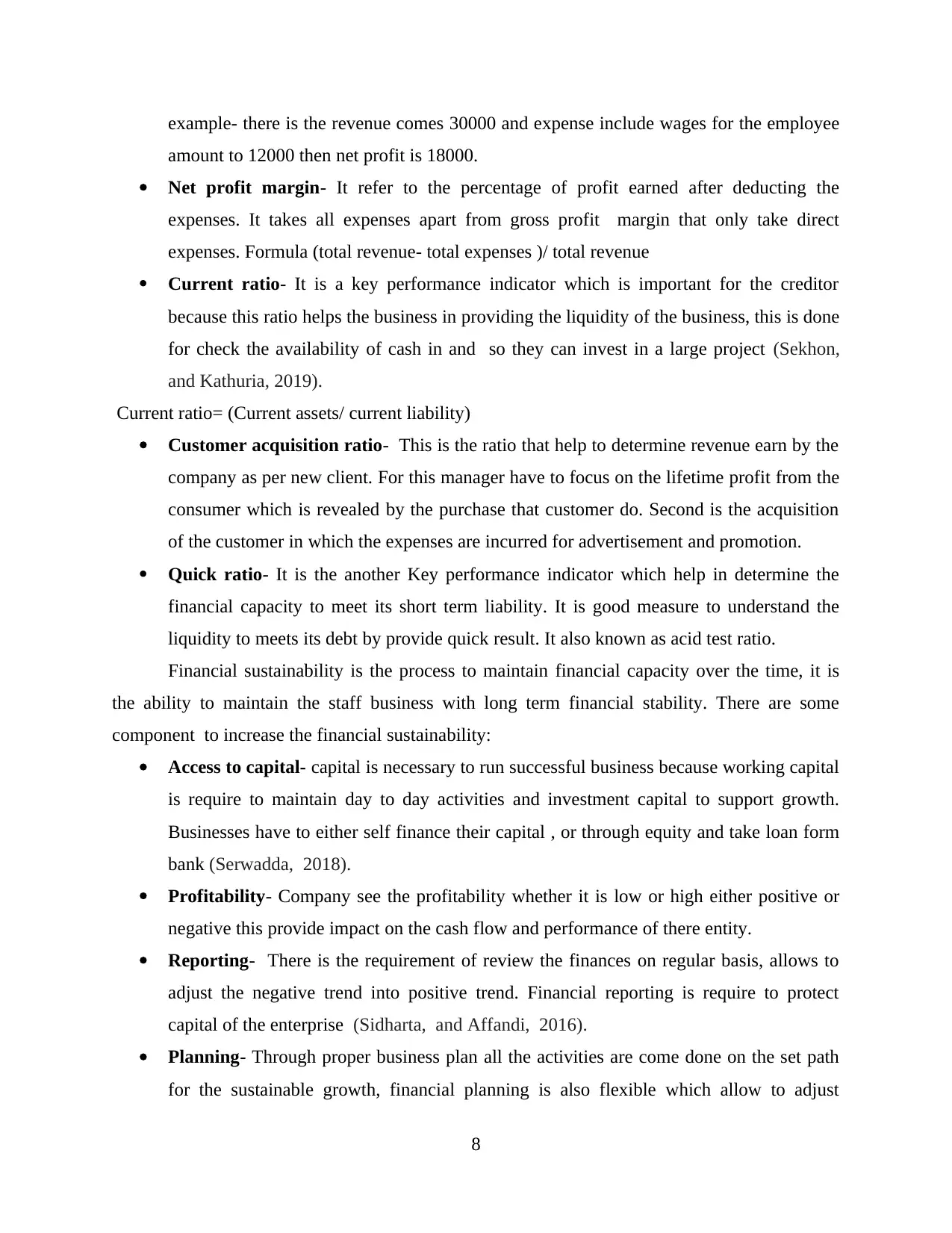
example- there is the revenue comes 30000 and expense include wages for the employee
amount to 12000 then net profit is 18000.
Net profit margin- It refer to the percentage of profit earned after deducting the
expenses. It takes all expenses apart from gross profit margin that only take direct
expenses. Formula (total revenue- total expenses )/ total revenue
Current ratio- It is a key performance indicator which is important for the creditor
because this ratio helps the business in providing the liquidity of the business, this is done
for check the availability of cash in and so they can invest in a large project (Sekhon,
and Kathuria, 2019).
Current ratio= (Current assets/ current liability)
Customer acquisition ratio- This is the ratio that help to determine revenue earn by the
company as per new client. For this manager have to focus on the lifetime profit from the
consumer which is revealed by the purchase that customer do. Second is the acquisition
of the customer in which the expenses are incurred for advertisement and promotion.
Quick ratio- It is the another Key performance indicator which help in determine the
financial capacity to meet its short term liability. It is good measure to understand the
liquidity to meets its debt by provide quick result. It also known as acid test ratio.
Financial sustainability is the process to maintain financial capacity over the time, it is
the ability to maintain the staff business with long term financial stability. There are some
component to increase the financial sustainability:
Access to capital- capital is necessary to run successful business because working capital
is require to maintain day to day activities and investment capital to support growth.
Businesses have to either self finance their capital , or through equity and take loan form
bank (Serwadda, 2018).
Profitability- Company see the profitability whether it is low or high either positive or
negative this provide impact on the cash flow and performance of there entity.
Reporting- There is the requirement of review the finances on regular basis, allows to
adjust the negative trend into positive trend. Financial reporting is require to protect
capital of the enterprise (Sidharta, and Affandi, 2016).
Planning- Through proper business plan all the activities are come done on the set path
for the sustainable growth, financial planning is also flexible which allow to adjust
8
amount to 12000 then net profit is 18000.
Net profit margin- It refer to the percentage of profit earned after deducting the
expenses. It takes all expenses apart from gross profit margin that only take direct
expenses. Formula (total revenue- total expenses )/ total revenue
Current ratio- It is a key performance indicator which is important for the creditor
because this ratio helps the business in providing the liquidity of the business, this is done
for check the availability of cash in and so they can invest in a large project (Sekhon,
and Kathuria, 2019).
Current ratio= (Current assets/ current liability)
Customer acquisition ratio- This is the ratio that help to determine revenue earn by the
company as per new client. For this manager have to focus on the lifetime profit from the
consumer which is revealed by the purchase that customer do. Second is the acquisition
of the customer in which the expenses are incurred for advertisement and promotion.
Quick ratio- It is the another Key performance indicator which help in determine the
financial capacity to meet its short term liability. It is good measure to understand the
liquidity to meets its debt by provide quick result. It also known as acid test ratio.
Financial sustainability is the process to maintain financial capacity over the time, it is
the ability to maintain the staff business with long term financial stability. There are some
component to increase the financial sustainability:
Access to capital- capital is necessary to run successful business because working capital
is require to maintain day to day activities and investment capital to support growth.
Businesses have to either self finance their capital , or through equity and take loan form
bank (Serwadda, 2018).
Profitability- Company see the profitability whether it is low or high either positive or
negative this provide impact on the cash flow and performance of there entity.
Reporting- There is the requirement of review the finances on regular basis, allows to
adjust the negative trend into positive trend. Financial reporting is require to protect
capital of the enterprise (Sidharta, and Affandi, 2016).
Planning- Through proper business plan all the activities are come done on the set path
for the sustainable growth, financial planning is also flexible which allow to adjust
8
Paraphrase This Document
Need a fresh take? Get an instant paraphrase of this document with our AI Paraphraser
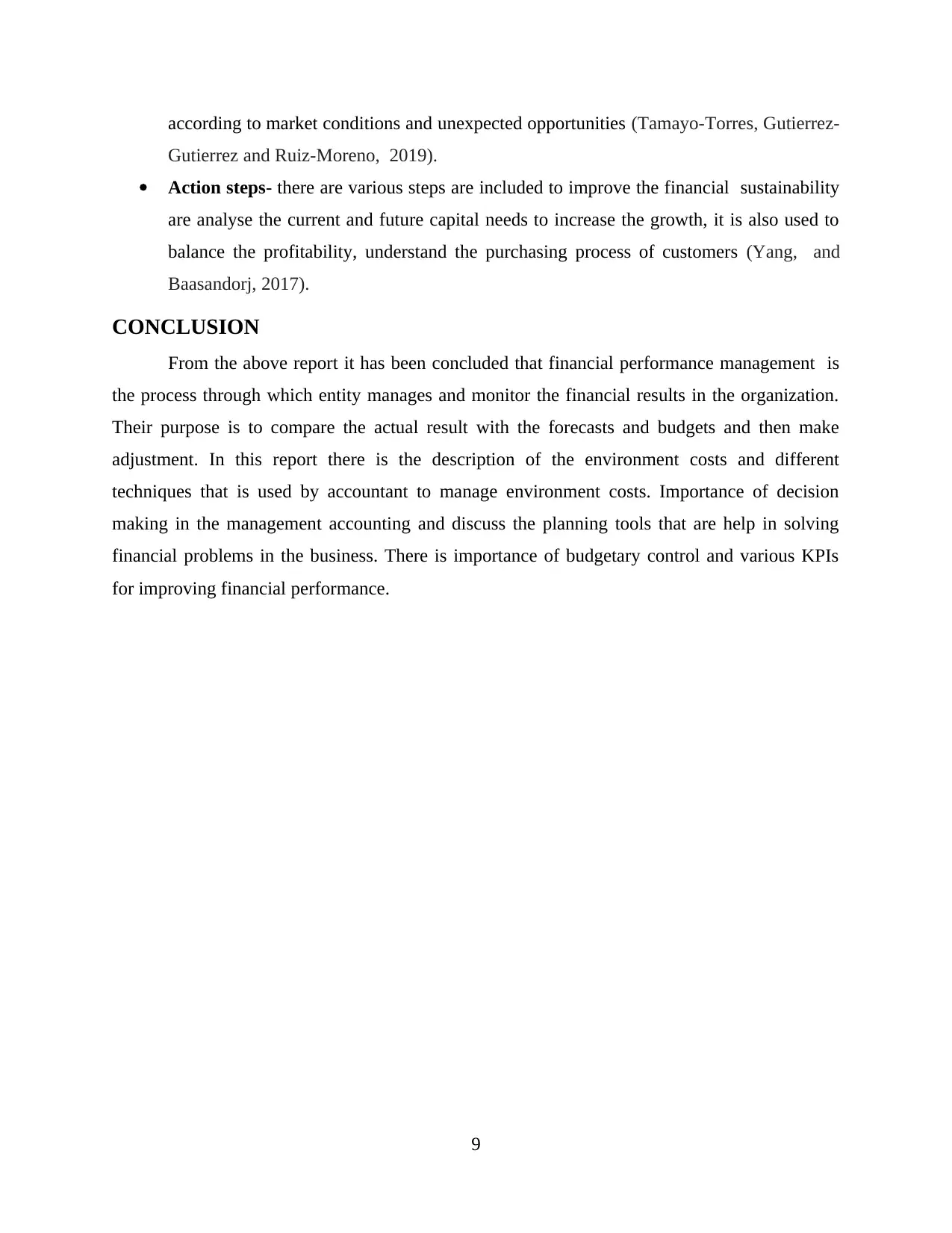
according to market conditions and unexpected opportunities (Tamayo-Torres, Gutierrez-
Gutierrez and Ruiz-Moreno, 2019).
Action steps- there are various steps are included to improve the financial sustainability
are analyse the current and future capital needs to increase the growth, it is also used to
balance the profitability, understand the purchasing process of customers (Yang, and
Baasandorj, 2017).
CONCLUSION
From the above report it has been concluded that financial performance management is
the process through which entity manages and monitor the financial results in the organization.
Their purpose is to compare the actual result with the forecasts and budgets and then make
adjustment. In this report there is the description of the environment costs and different
techniques that is used by accountant to manage environment costs. Importance of decision
making in the management accounting and discuss the planning tools that are help in solving
financial problems in the business. There is importance of budgetary control and various KPIs
for improving financial performance.
9
Gutierrez and Ruiz-Moreno, 2019).
Action steps- there are various steps are included to improve the financial sustainability
are analyse the current and future capital needs to increase the growth, it is also used to
balance the profitability, understand the purchasing process of customers (Yang, and
Baasandorj, 2017).
CONCLUSION
From the above report it has been concluded that financial performance management is
the process through which entity manages and monitor the financial results in the organization.
Their purpose is to compare the actual result with the forecasts and budgets and then make
adjustment. In this report there is the description of the environment costs and different
techniques that is used by accountant to manage environment costs. Importance of decision
making in the management accounting and discuss the planning tools that are help in solving
financial problems in the business. There is importance of budgetary control and various KPIs
for improving financial performance.
9
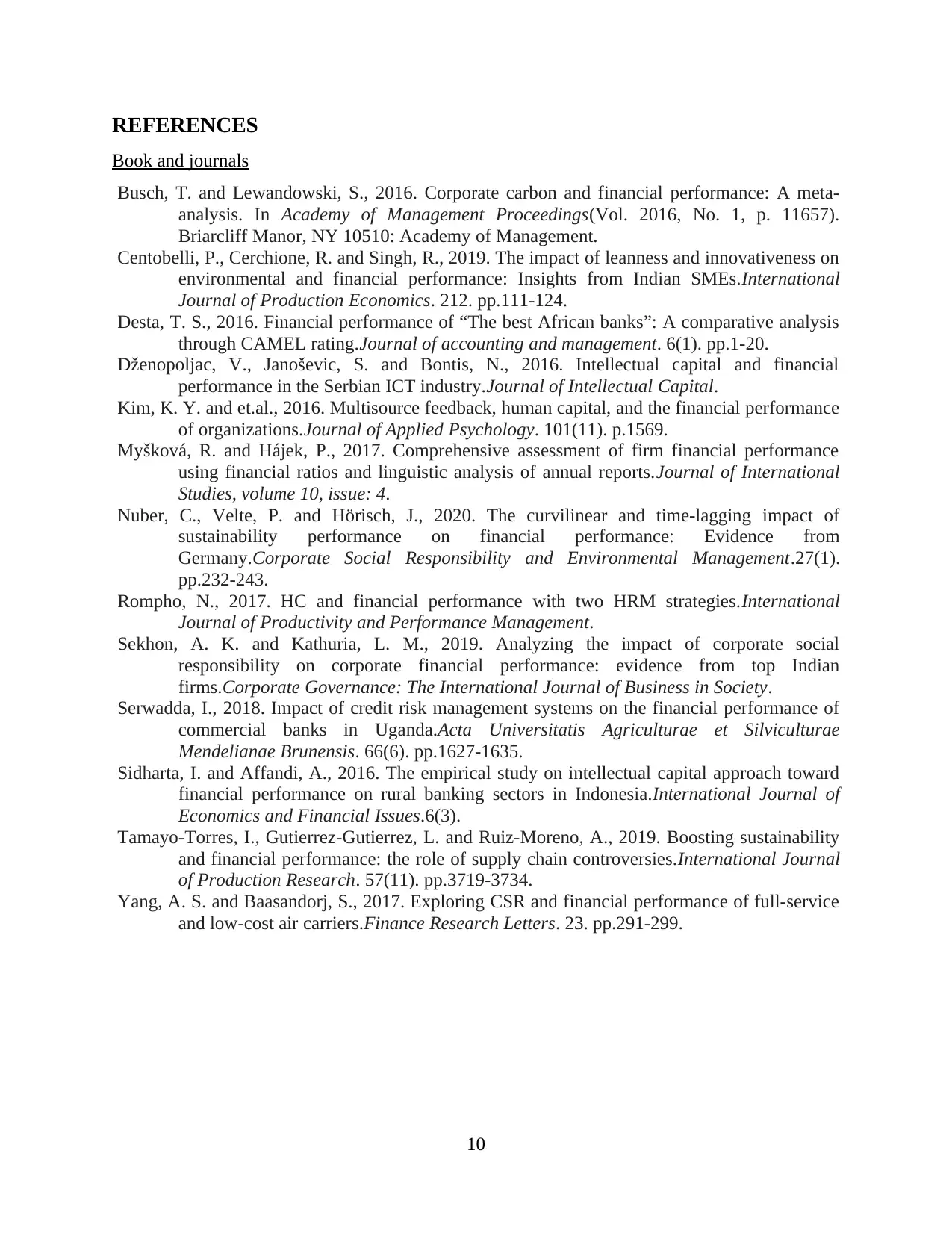
REFERENCES
Book and journals
Busch, T. and Lewandowski, S., 2016. Corporate carbon and financial performance: A meta-
analysis. In Academy of Management Proceedings(Vol. 2016, No. 1, p. 11657).
Briarcliff Manor, NY 10510: Academy of Management.
Centobelli, P., Cerchione, R. and Singh, R., 2019. The impact of leanness and innovativeness on
environmental and financial performance: Insights from Indian SMEs.International
Journal of Production Economics. 212. pp.111-124.
Desta, T. S., 2016. Financial performance of “The best African banks”: A comparative analysis
through CAMEL rating.Journal of accounting and management. 6(1). pp.1-20.
Dženopoljac, V., Janoševic, S. and Bontis, N., 2016. Intellectual capital and financial
performance in the Serbian ICT industry.Journal of Intellectual Capital.
Kim, K. Y. and et.al., 2016. Multisource feedback, human capital, and the financial performance
of organizations.Journal of Applied Psychology. 101(11). p.1569.
Myšková, R. and Hájek, P., 2017. Comprehensive assessment of firm financial performance
using financial ratios and linguistic analysis of annual reports.Journal of International
Studies, volume 10, issue: 4.
Nuber, C., Velte, P. and Hörisch, J., 2020. The curvilinear and time‐lagging impact of
sustainability performance on financial performance: Evidence from
Germany.Corporate Social Responsibility and Environmental Management.27(1).
pp.232-243.
Rompho, N., 2017. HC and financial performance with two HRM strategies.International
Journal of Productivity and Performance Management.
Sekhon, A. K. and Kathuria, L. M., 2019. Analyzing the impact of corporate social
responsibility on corporate financial performance: evidence from top Indian
firms.Corporate Governance: The International Journal of Business in Society.
Serwadda, I., 2018. Impact of credit risk management systems on the financial performance of
commercial banks in Uganda.Acta Universitatis Agriculturae et Silviculturae
Mendelianae Brunensis. 66(6). pp.1627-1635.
Sidharta, I. and Affandi, A., 2016. The empirical study on intellectual capital approach toward
financial performance on rural banking sectors in Indonesia.International Journal of
Economics and Financial Issues.6(3).
Tamayo-Torres, I., Gutierrez-Gutierrez, L. and Ruiz-Moreno, A., 2019. Boosting sustainability
and financial performance: the role of supply chain controversies.International Journal
of Production Research. 57(11). pp.3719-3734.
Yang, A. S. and Baasandorj, S., 2017. Exploring CSR and financial performance of full-service
and low-cost air carriers.Finance Research Letters. 23. pp.291-299.
10
Book and journals
Busch, T. and Lewandowski, S., 2016. Corporate carbon and financial performance: A meta-
analysis. In Academy of Management Proceedings(Vol. 2016, No. 1, p. 11657).
Briarcliff Manor, NY 10510: Academy of Management.
Centobelli, P., Cerchione, R. and Singh, R., 2019. The impact of leanness and innovativeness on
environmental and financial performance: Insights from Indian SMEs.International
Journal of Production Economics. 212. pp.111-124.
Desta, T. S., 2016. Financial performance of “The best African banks”: A comparative analysis
through CAMEL rating.Journal of accounting and management. 6(1). pp.1-20.
Dženopoljac, V., Janoševic, S. and Bontis, N., 2016. Intellectual capital and financial
performance in the Serbian ICT industry.Journal of Intellectual Capital.
Kim, K. Y. and et.al., 2016. Multisource feedback, human capital, and the financial performance
of organizations.Journal of Applied Psychology. 101(11). p.1569.
Myšková, R. and Hájek, P., 2017. Comprehensive assessment of firm financial performance
using financial ratios and linguistic analysis of annual reports.Journal of International
Studies, volume 10, issue: 4.
Nuber, C., Velte, P. and Hörisch, J., 2020. The curvilinear and time‐lagging impact of
sustainability performance on financial performance: Evidence from
Germany.Corporate Social Responsibility and Environmental Management.27(1).
pp.232-243.
Rompho, N., 2017. HC and financial performance with two HRM strategies.International
Journal of Productivity and Performance Management.
Sekhon, A. K. and Kathuria, L. M., 2019. Analyzing the impact of corporate social
responsibility on corporate financial performance: evidence from top Indian
firms.Corporate Governance: The International Journal of Business in Society.
Serwadda, I., 2018. Impact of credit risk management systems on the financial performance of
commercial banks in Uganda.Acta Universitatis Agriculturae et Silviculturae
Mendelianae Brunensis. 66(6). pp.1627-1635.
Sidharta, I. and Affandi, A., 2016. The empirical study on intellectual capital approach toward
financial performance on rural banking sectors in Indonesia.International Journal of
Economics and Financial Issues.6(3).
Tamayo-Torres, I., Gutierrez-Gutierrez, L. and Ruiz-Moreno, A., 2019. Boosting sustainability
and financial performance: the role of supply chain controversies.International Journal
of Production Research. 57(11). pp.3719-3734.
Yang, A. S. and Baasandorj, S., 2017. Exploring CSR and financial performance of full-service
and low-cost air carriers.Finance Research Letters. 23. pp.291-299.
10
⊘ This is a preview!⊘
Do you want full access?
Subscribe today to unlock all pages.

Trusted by 1+ million students worldwide
1 out of 13
Related Documents
Your All-in-One AI-Powered Toolkit for Academic Success.
+13062052269
info@desklib.com
Available 24*7 on WhatsApp / Email
![[object Object]](/_next/static/media/star-bottom.7253800d.svg)
Unlock your academic potential
Copyright © 2020–2025 A2Z Services. All Rights Reserved. Developed and managed by ZUCOL.





